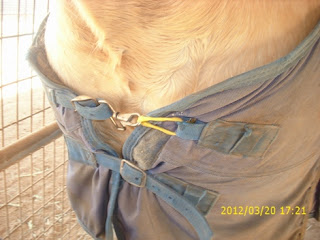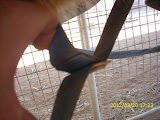Improvised Horse-Blanket Repairs
Sometimes blanket components will break and you gotta fix 'em now. For example, a front buckle will break away from its retaining tab. So get a snap, and route the strap through the snap and through the buckle. Improvise a loop using twine through the buckle retaining loop.
1 This is the first looping of the strap on the off-side of the horse through the snap and the buckle. Make the twine loop and push the knots into the buckle retaining loop on the near-side of the horse.
2 Here is another view of the repair. Note how the strap on the off-side of the horse is looped over the standing edge of the buckle. A better way is in the next picture.
3 Here is how the repair looks with the off-side strap looped through the snap and under the the standing edge of the buckle. This is a much better improvised repair.
Or, a girth-strap snap will break and the strap is sewn around the slide adjuster blocking a simple replacement. Pictures #4 & 5 show the situation. Cut the thread from the strap end sewn around the slide adjuster. Remove the strap end from the slide adjuster. Remove the broken snap as need. Thread the strap end through a replacement snap and through the slide adjuster. Pictures #6 & 7 show the situation.
4 Here is a sewn up girth-strap.
5 Another view of the sewn-up girth-strap
6. A view of the repair. Route the running end of the girth-strap through a replacement girth-snap and through the slide-adjuster
7. The repair is functionally indistinguishable from the factory construction
2012.03.25





































